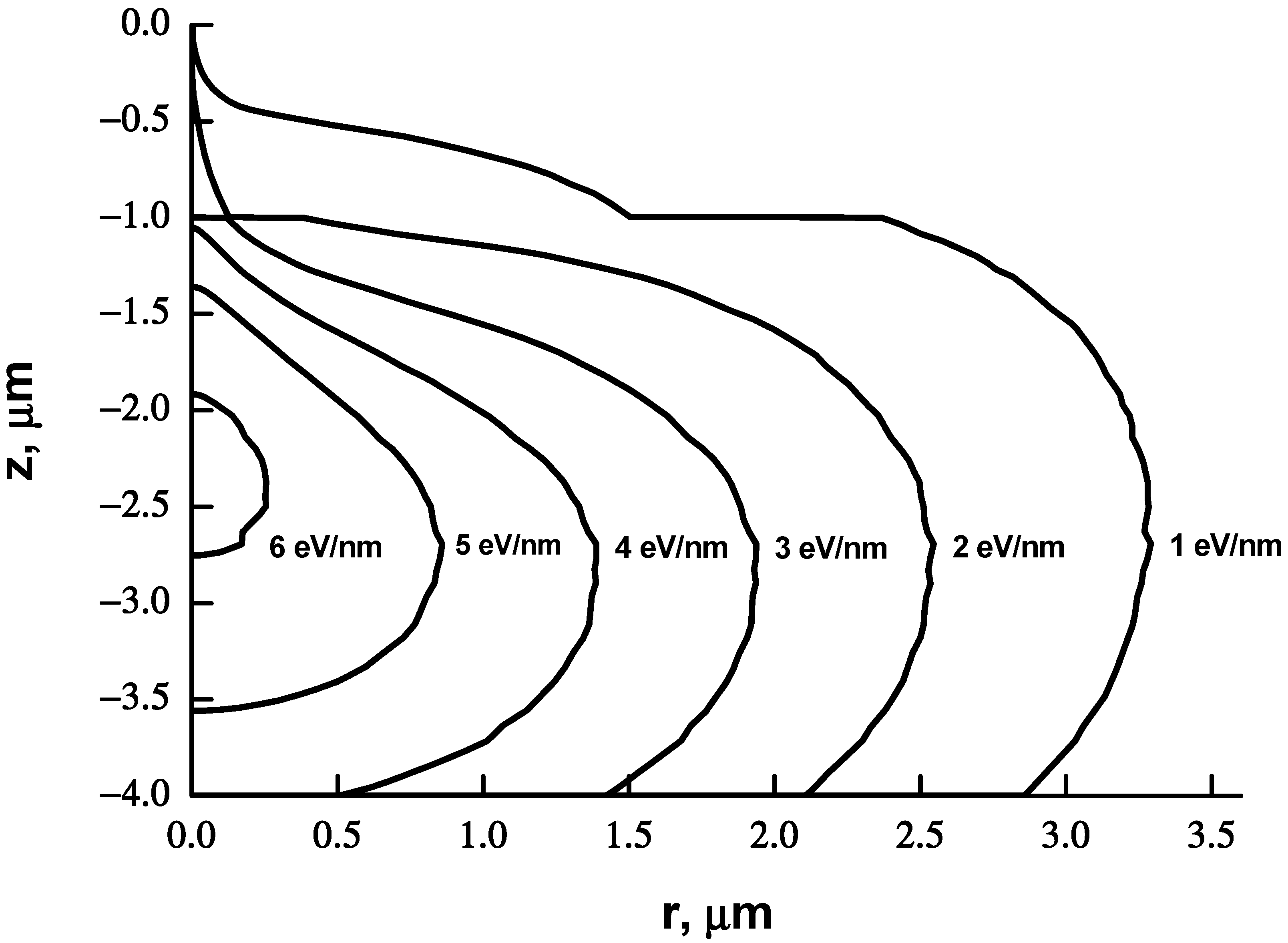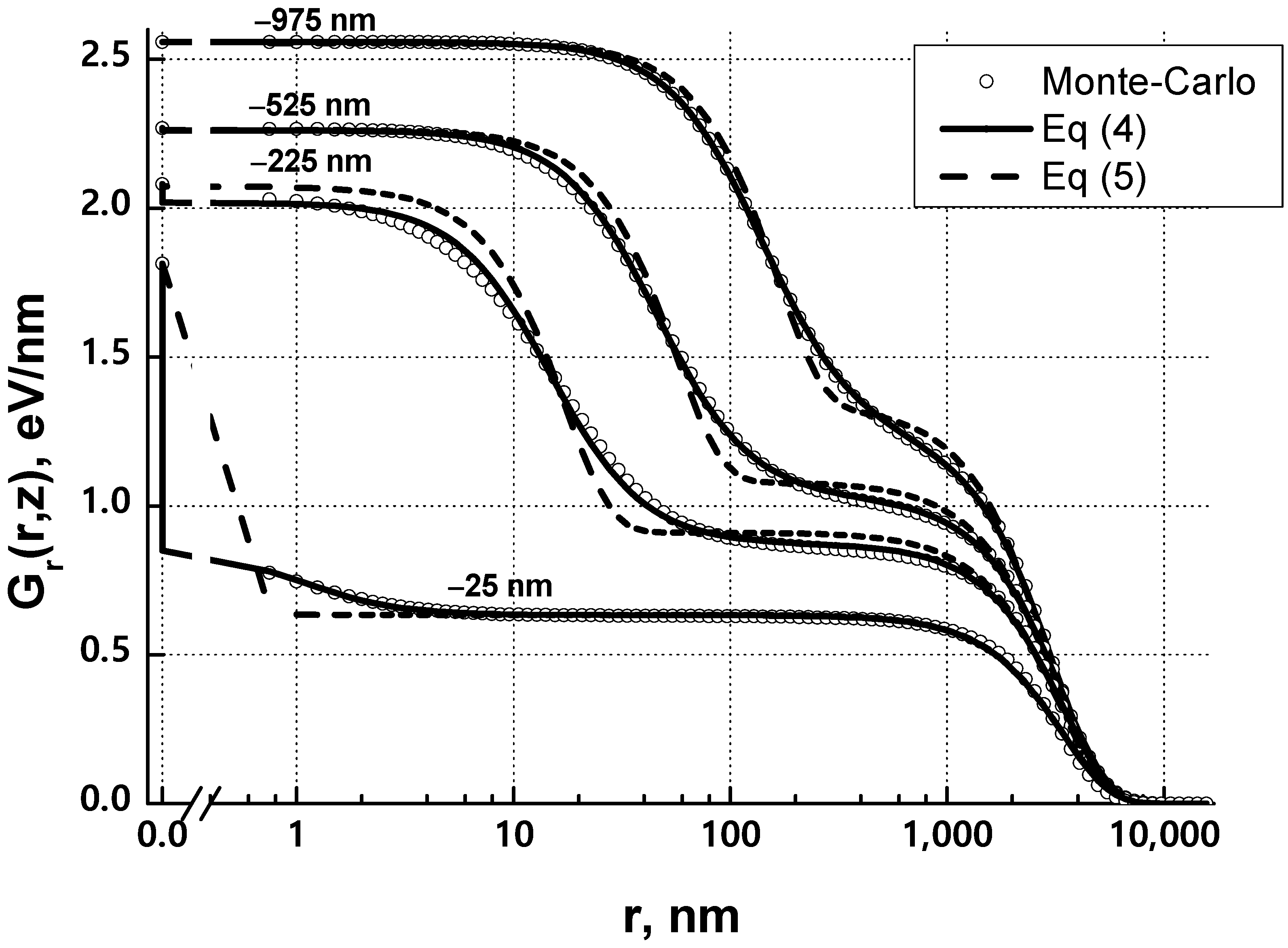Calculation of the Absorbed Electron Energy 3D Distribution by the Monte Carlo Method, Presentation of the Proximity Function by Three Parameters α, β, η and Comparison with the Experiment
Abstract
:1. Introduction
2. Theory and Calculation
2.1. Calculation of Electron Scattering in Layered Materials by the Monte Carlo Method
2.2. Integral Proximity Function: Fitting of Absorbed Energy Distribution by Elementary Functions
2.3. Fitting with Three Parameters: Analogue of Experiment
3. Results and Discussion
4. Conclusions
Author Contributions
Funding
Institutional Review Board Statement
Informed Consent Statement
Data Availability Statement
Conflicts of Interest
Appendix A
References
- Gurtovoi, V.L.; Burlakov, A.A.; Nikulov, A.V.; Tulin, V.A.; Firsov, A.A.; Antonov, V.N.; Davis, R.; Pelling, S. Multiple current states of two phase-coupled superconducting rings. JETP 2011, 113, 678–682. [Google Scholar] [CrossRef]
- Kuznetsov, V.I.; Firsov, A.A. Unusual quantum magnetic-resistive oscillations in a superconducting structure of two circular asymmetric loops in series. Phys. C 2013, 492, 11–17. [Google Scholar] [CrossRef] [Green Version]
- Knyazev, M.A.; Svintsov, A.A.; Fahrtdinov, R.R. Development of Field Alignment Methods for Electron-Вeam Lithography in the Case of X-ray Bragg–Fresnel Lenses. J. Surf. Investig. X-ray Synchrotron Neutron Tech. 2018, 12, 957–960. [Google Scholar] [CrossRef]
- Firsov, A.A.; Svintsov, A.A.; Zaitsev, S.I.; Erko, A.; Aristov, V.V. The first synthetic X-ray hologram: Results. Opt. Commun. 2002, 202, 55–59. [Google Scholar] [CrossRef]
- Grigoriev, M.; Fakhrtdinov, R.; Irzhak, D.; Firsov, A.; Firsov, A.; Svintsov, A.; Erko, A.; Roshchupkin, D. Two-dimensional X-ray focusing by off-axis grazing incidence phase Fresnel zone plate on the laboratory X-ray source. Opt. Commun. 2017, 385, 15–19. [Google Scholar] [CrossRef]
- Novoselov, K.S.; Geim, A.K.; Morozov, S.V.; Jiang, D.; Katsnelson, M.I.; Grigorieva, I.V.; Dubonos, S.V.; Firsov, A.A. Two-dimensional gas of massless Dirac fermions in graphene. Nature 2005, 438, 197–200. [Google Scholar] [CrossRef]
- Morozov, S.V.; Novoselov, K.S.; Schedin, F.; Jiang, D.; Firsov, A.A.; Geim, A.K. Two-Dimensional Electron and Hole Gases at the Surface of Graphite. Phys. Rev. B 2005, 72, 201401. [Google Scholar] [CrossRef] [Green Version]
- Chang, T.H.P. Proximity effect in electron-beam lithography. J. Vac. Sci. Technol. 1975, 12, 1271–1275. [Google Scholar] [CrossRef]
- Parikh, M. Corrections to proximity effects in electron–beam lithography. 1. Theory. J. Appl. Phys. 1979, 50, 4371–4377. [Google Scholar] [CrossRef]
- Aristov, V.V.; Gaifullin, B.N.; Svintsov, A.A.; Zaitsev, S.I.; Jede, R.R.; Raith, H.F. Accuracy of proximity correction in electron lithography after development. J. Vac. Sci. Technol. 1992, 10, 2459–2467. [Google Scholar] [CrossRef]
- Greeneich, J.S.; Van Duzer, T. An exposure model for electron-sensitive resists. IEEE Trans. Electron. 1974, 21, 286–299. [Google Scholar] [CrossRef]
- Parikh, M.; Kyser, D. Energy deposition functions in electron resist films on substrates. J. Appl. Phys. 1979, 50, 1104–1111. [Google Scholar] [CrossRef]
- Available online: https://www.raith.com/technology/nanofabrication-software/proximity-effect-correction/ (accessed on 26 May 2022).
- Available online: https://www.genisys-gmbh.com/part-1-electron-scattering-and-proximity-effect.html (accessed on 26 May 2022).
- Lee, S.-Y.; Dai, Q.; Lee, S.-H.; Kim, B.-G.; Cho, H.-K. Enhancement of spatial resolution in generating point spread functions by Monte Carlo simulation in electron-beam lithography. J. Vac. Sci. Technol. B 2011, 29, 06F902. [Google Scholar] [CrossRef]
- Li, P. A Review of Proximity Effect Correction in Electron-beam Lithography. arXiv 2015, arXiv:1509.05169. [Google Scholar]
- Figueiro, T.R. Process Modeling for Proximity Effect Correction in Electron Beam Lithography. Micro and Nanotechnologies/Microelectronics. Doctoral Dissertation, Université Grenoble Alpes, Gières, France, 2015. [Google Scholar]
- Fretwell, T.A.; Gurung, R.; Jones, P.L. Curve fittin to Monte Carlo data for the determination of proximity effect correction parameters. Microelectron. Eng. 1992, 17, 389–394. [Google Scholar] [CrossRef]
- Katia, V.; Georgi, M. Modelling of exposure and development processes in electron and ion lithography. Model. Simul. Mater. Sci. Eng. 1994, 2, 239–254. [Google Scholar] [CrossRef]
- Katia, V.; Georgi, M. Computer Simulation of Processes at Electron and Ion Beam Lithography. In Lithography; Wang, M., Ed.; Intech: Rijeka, Croatia, 2010; pp. 319–350. [Google Scholar] [CrossRef] [Green Version]
- Aparshina, L.I.; Dubonos, S.V.; Maksimov, S.V.; Svintsov, A.A.; Zaitsev, S.I. Energy dependence of proximity parameters investigated by fitting before measurement tests. J. Vac. Sci. Technol. B. 1997, 15, 2298–2302. [Google Scholar] [CrossRef]
- Rooks, M.; Belic, N.; Kratschmer, E.; Viswanathan, R. Experimental optimization of the electron-beam proximity effect forward scattering parameter. J. Vac. Sci. Technol. B 2005, 23, 2769–2775. [Google Scholar] [CrossRef]
- Stevens, L.; Jonckheere, R.; Froyen, E.; Decoutere, S.; Lanneer, D. Determination of the proximity parameters in electron beam lithography using doughnut-structures. Microelectron. Eng. 1986, 5, 141–150. [Google Scholar] [CrossRef]
- Hawryluk, R.; Hawryluk, A.; Smith, H. Energy dissipation in a thin polymer film by electron beam scattering. J. Appl. Phys. 1974, 45, 2551–2566. [Google Scholar] [CrossRef]
- Pavlov, V.N.; Panchenko, V.Y.; Polikarpov, M.A.; Svintsov, A.A.; Yakimov, E.B. Simulation of the current induced by 63Ni beta radiation. J. Surf. Investig. X-ray Synchrotron Neutron Tech. 2013, 7, 852–857. [Google Scholar] [CrossRef]
- Zaitsev, S.I.; Pavlov, V.N.; Panchenko, V.Y.; Polikarpov, M.A.; Svintsov, A.A.; Yakimov, E.B. Comparison of the efficiency of 63Ni beta-radiation detectors made from silicon and wide-gap semiconductors. J. Synch. Investig. 2014, 8, 843–845. [Google Scholar] [CrossRef]
- Reimer, L. Scanning Electron Microscopy. Physics of Image Formation and Microanalysis; Springer Series in Optical Sciences; Peter, W., Ed.; Springer: Hawkes, ON, Canada, 1998; Volume 45. [Google Scholar]
- Bronstein, I.M.; Fraiman, B.S. Secondary Electron Emission; Nauka: Moscow, Russia, 1969; p. 170. [Google Scholar]
- Zaistev, S.I.; Svintsov, A.A. Theory of isotropic local etching. Problem statement and basic equation. Poverhnost 1986, 4, 27–35. [Google Scholar]
- Zaistev, S.I.; Svintsov, A.A. Theory of isotropic local etching. Properties and some analytical solution. Poverhnost 1987, 1, 47–56. [Google Scholar]


| E, keV | 15 | 25 | 35 | |||
|---|---|---|---|---|---|---|
| H0, nm | αe, nm | αs, nm | αe, nm | αs, nm | αe, nm | αs, nm |
| 100 | 6 | 4 | 3 | 2 | 2 | 1 |
| 200 | 16 | 12 | 10 | 6 | 7 | 5 |
| 500 | 64 | 56 | 39 | 30 | 28 | 20 |
| 1000 | 182 | 183 | 110 | 96 | 79 | 65 |
| 1500 | 334 | 342 | 202 | 196 | 145 | 130 |
| Substrate | Si | GaAs | ||||||
|---|---|---|---|---|---|---|---|---|
| Density | 2330 kg/m3 | 5350 kg/m3 | ||||||
| E, keV | βe | βs | ηe | ηs | βe | βs | ηe | ηs |
| 11 | 0.9 | 0.85 | - | 0.93 | - | 0.73 | - | 1.23 |
| 15 | 1.5 | 1.33 | - | 0.87 | - | 0.92 | - | 1.24 |
| 20 | 2.2 | 2.11 | - | 0.79 | 1.2 | 1.17 | - | 1.23 |
| 25 | 3.1 | 3.01 | 0.7 | 0.73 | 1.5 | 1.48 | 1.4 | 1.16 |
| 30 | 4 | 4.08 | - | 0.69 | 2 | 1.85 | 1.11 | |
| 35 | 5.8 | 5.32 | - | 0.66 | 2.3 | 2.29 | - | 1.07 |
| 39 | - | 6.39 | - | 0.63 | 2.6 | 2.66 | - | 1.04 |
| Substrate | Al2O3 | KAl2Si3O10(OH)2 (mica) | ||||||
|---|---|---|---|---|---|---|---|---|
| Density | 3970 kg/m3 | 2850 kg/m3 | ||||||
| E, keV | βe | βs | ηe | ηs | βe | βs | ηe | ηs |
| 11 | - | 0.76 | - | 0.76 | 0.75 | 0.81 | - | 0.81 |
| 15 | 1. | 1.02 | - | 0.72 | 1.2 | 1.19 | - | 0.75 |
| 20 | - | 1.47 | - | 0.65 | 2 | 1.82 | - | 0.62 |
| 25 | 2 | 2.05 | 0.8 | 0.59 | 2.7 | 2.58 | 0.5 | 0.61 |
| 30 | - | 2.71 | - | 0.56 | 3.7 | 3.53 | - | 0.59 |
| 35 | 3.4 | 3.48 | - | 0.53 | 4.8 | 4.59 | - | 0.56 |
| 39 | - | 4.19 | - | 0.52 | - | 5.54 | - | 0.54 |
| Substrate | Ge | С (Diamond) | ||||||
|---|---|---|---|---|---|---|---|---|
| Density | 5323 kg/m3 | 3500 kg/m3 | ||||||
| E, keV | βe | βs | ηe | ηs | βe | βs | ηe | ηs |
| 11 | - | 0.73 | - | 1.26 | 0.7 | 0.79 | - | 0.51 |
| 15 | 0.7 | 0.92 | - | 1.28 | 1.0 | 1.08 | - | 0.41 |
| 20 | 1.1 | 1.15 | - | 1.24 | 1.6 | 1.61 | - | 0.33 |
| 25 | 1.4 | 1.46 | 1.1 | 1.18 | 2.1 | 2.23 | 0.4 | 0.3 |
| 30 | 1.8 | 1.84 | - | 1.12 | 2.6 | 2.96 | - | 0.29 |
| 35 | 2.5 | 2.27 | - | 1.08 | 3.6 | 3.87 | - | 0.26 |
| 39 | - | 2.67 | - | 1.06 | - | 4.63 | - | 0.25 |
Publisher’s Note: MDPI stays neutral with regard to jurisdictional claims in published maps and institutional affiliations. |
© 2022 by the authors. Licensee MDPI, Basel, Switzerland. This article is an open access article distributed under the terms and conditions of the Creative Commons Attribution (CC BY) license (https://creativecommons.org/licenses/by/4.0/).
Share and Cite
Svintsov, A.A.; Knyazev, M.A.; Zaitsev, S.I. Calculation of the Absorbed Electron Energy 3D Distribution by the Monte Carlo Method, Presentation of the Proximity Function by Three Parameters α, β, η and Comparison with the Experiment. Materials 2022, 15, 3888. https://doi.org/10.3390/ma15113888
Svintsov AA, Knyazev MA, Zaitsev SI. Calculation of the Absorbed Electron Energy 3D Distribution by the Monte Carlo Method, Presentation of the Proximity Function by Three Parameters α, β, η and Comparison with the Experiment. Materials. 2022; 15(11):3888. https://doi.org/10.3390/ma15113888
Chicago/Turabian StyleSvintsov, Alexander A., Maxim A. Knyazev, and Sergey I. Zaitsev. 2022. "Calculation of the Absorbed Electron Energy 3D Distribution by the Monte Carlo Method, Presentation of the Proximity Function by Three Parameters α, β, η and Comparison with the Experiment" Materials 15, no. 11: 3888. https://doi.org/10.3390/ma15113888
APA StyleSvintsov, A. A., Knyazev, M. A., & Zaitsev, S. I. (2022). Calculation of the Absorbed Electron Energy 3D Distribution by the Monte Carlo Method, Presentation of the Proximity Function by Three Parameters α, β, η and Comparison with the Experiment. Materials, 15(11), 3888. https://doi.org/10.3390/ma15113888






